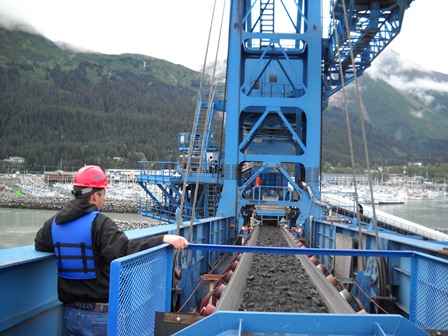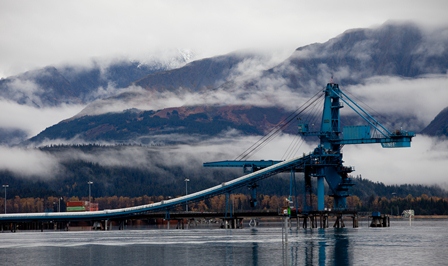A Complete Conveyor System Upgrade At Port of Seward
Published: June 15th 2012
 [Seward, AK] - The Port of Seward has completed a conveyor system upgrade for its coal handling operations that has raised throughput by an estimated 20%, allowing Alaska’s largest coal producer to better compete for international customers. By installing the new EVO® Conveyor Load Zone from Martin Engineering, the terminal has increased the average load rate for the entire ship loading process from 700 mt/h to 858 mt/h, while dramatically enhancing control over dust and fugitive particle emissions.
[Seward, AK] - The Port of Seward has completed a conveyor system upgrade for its coal handling operations that has raised throughput by an estimated 20%, allowing Alaska’s largest coal producer to better compete for international customers. By installing the new EVO® Conveyor Load Zone from Martin Engineering, the terminal has increased the average load rate for the entire ship loading process from 700 mt/h to 858 mt/h, while dramatically enhancing control over dust and fugitive particle emissions.
With throughput increased, ship loading times are being reduced, driving down costs and making the exported coal more affordable to overseas buyers. “Basically, we should be able to knock one day off our loading time for each ship,” observed Steve Denton, VP of Business Development for Usibelli Coal Mines.
The terminal has progressed from an absolute maximum of 18,000 mt/d with dry coal and optimal loading conditions to more than 20,000 mt/d on average -- including operations in poor weather and less than ideal operating conditions. “Over the course of a million tons per year, that’s a major savings for our customers, as they’ll be able to enjoy better FOB prices. We also save on the cost of ship demurrage, which helps pay for the cost of the conveyor investment,” Denton said.
Port A Critical Link
Since 1985, the Port of Seward has shipped over 16 million mt of coal, all of it originating at the Usibelli Coal Mine 400 miles to the north, which currently exports more than 45% of its annual production. UCM and its affiliate Aurora Energy Services, LLC (operator of the Seward coal terminal) have no doubt that the port plays a key role in their future. With one of Alaska’s few year-round ice-free harbors, Seward has the ship-loading resources to feed the expanding international export market. It’s also the southern terminus of the state-owned Alaska Railroad, with terminal facilities owned by the railroad and operated by AES.
A major obstacle to expansion was the port facility’s aging infrastructure, which had seen few improvements prior to 1999. Upgrades began that year when Alaska Railroad purchased the terminal, but despite best efforts, by 2008 the facility had become a logistical bottleneck and a source of occasional dust complaints.
One of the issues was the ship loader itself. With a view to expanding Usibelli’s export market share, AES began taking steps to increase throughput at the Port facility, but initial efforts to reach 2,000 mt/h proved almost entirely unsuccessful. “Working with what we had, we could only reach 600-700 mt/h,” said AES Terminal General Foreman Vic Stoltz. “We made some improvements and got up to a steady run rate of 750 mt/h. But there were still some major issues with coal backing up in the chute.”
Even as some gains were realized, AES found that with higher-speed operation, dust became an increasing problem. The ship loader wasn’t designed to contain fugitive material, and airborne coal dust generated negative attention, threatening community relations. The company reports that the recent chute upgrades have virtually eliminated spillage and dust issues.
 Combining Solutions
Combining Solutions
The need to increase throughput at Seward while protecting the region’s air quality and natural splendor led AES to investigate new conveyor technology from Martin Engineering. After testing the Usibelli coal to determine its flow properties, Martin specialists used Discrete Element Method modeling to design a chute capable of properly handling the coal.
“When we got back the computer models, we saw that we were able to pass 1500 mt/h and still control dust, all while keeping within our capital budget,” said Stoltz. “When our management realized that we could increase throughput, increase safety and reduce our environmental impact all at once, they were completely in favor of implementing the suggested upgrades,” he recalled.
A New Conveyor Architecture
The new transfer point makes use of Martin® Inertial Flow™ Transfer technology, the entire chute custom-engineered and modeled in 3-D to provide the optimum design for the material and flow rate needed. The “hood” controls the flow of material from the discharging conveyor, maintaining a coherent material stream and minimizing induced air. A smooth loading chute (“spoon”) places the stream of coal onto the ship loader’s boom conveyor at the proper speed and angle with minimal impact, reducing material degradation, belt abrasion and the expulsion of airborne dust.
Martin Engineering supplied other redesigned components to contain material and improve serviceability. Belt support cradles were installed under the drop chute to absorb impact and stabilize the belt line and prevent spillage. AES also mounted EVO® External Wear Liner on the load zone’s existing skirtboard for improved sealing. Because it is attached from the outside, it is easier to install, inspect and adjust than conventional seals, without requiring confined space entry.
Results
The first thing the AES crew noticed was an improved material load rate. During the initial shakedown run, operators noted the conveyor’s weigh scale pegged at 100%, but the belt didn’t shut down. The old system peaked at 1000 mt/h (including ship and hatch moves), but with new components in place, the system now hits peaks of 1500 mt/h. “We don’t have slowdowns due to the chute clogging up, which previously was a constant battle,” Stoltz added.
Equally important, following the system’s initial run, the ship loading area was virtually free of fugitive material and dust build-up, allowing AES crews to reduce their cleanup time from days to just hours. “The clean-up time has been reduced by more than 40 man-hours per shipload,” said Stoltz.
Reducing Risk
To AES, the environmental and worker safety benefits of Martin Engineering’s upgrades have been just as important as the production advantages. “Faster loading times help manage our risk, from both the environmental and safety perspectives,” commented Bart Coiley, AES Manager of Environmental Affairs. “The longer it takes to load a ship, the greater the chances of creating dust.”
Summarizing the experience, Denton said, “The work that Martin Engineering did eliminated a chronic bottleneck for us. There were many things we were doing to increase our throughput, but it was impossible to realize the full benefits until we cleaned up our loading operation with the installation of the new EVO® hood and spoon transfer chute.” Stoltz added: “With these upgrades, we’re earning our money back every time we start it up.”